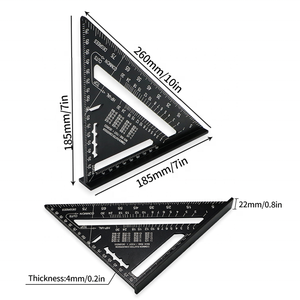Introduction to Tri Square
The tri square, also known as a framing square, is an essential tool for carpenters and woodworkers alike. This triangular-shaped measuring instrument is designed for a variety of purposes, including layout, marking, and checking the squareness of joints. Its versatility makes it a staple in woodworking shops and construction sites. Understanding the different types, functions, and applications of the tri square can greatly enhance your woodworking precision and efficiency.
Types of Tri Square
Tri squares come in several variations, each tailored to specific tasks in woodworking and construction:
- Standard Tri Square: Typically made from wood or metal, this is the most common version and is ideal for general carpentry tasks.
- Bevel Tri Square: Features an adjustable blade, allowing users to measure and mark angles other than 90 degrees.
- Steel Tri Square: Offers durability and accuracy, making it perfect for professionals who require precision in their measurements.
- Combination Square: A versatile tool that combines a tri square with a ruler, allowing for both straight measurements and angle checks.
Function and Feature of Tri Square
The tri square boasts several key functions and features that make it an invaluable tool in any woodworking endeavor:
- Accuracy: The primary purpose of a tri square is to ensure that angles are square, guaranteeing that cuts and joints fit together precisely.
- Durability: Most tri squares are made from high-quality materials such as stainless steel or sturdy wood, ensuring long-lasting use.
- Easy to Use: With a straightforward design, even novice woodworkers can quickly learn to use a tri square effectively.
- Lightweight: Despite its solid construction, a tri square remains relatively light, making it easy to handle and transport.
Applications of Tri Square
The versatility of the tri square extends across various applications in woodworking and construction, including:
- Framing: Essential for checking the squareness of framed structures, ensuring that everything remains level and properly aligned.
- Furniture Making: Used to measure and mark precise angles for furniture joints, enhancing both durability and aesthetics.
- Flooring Installation: Ensures the even placement of tiles or planks by checking the angles and squaring off the corners.
- Layout Work: Ideal for marking lines on lumber for cutting or routing, aiding in accurate project execution.












































